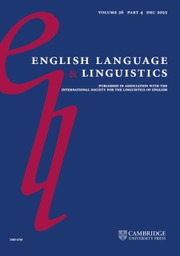No CrossRef data available.
Article contents
On the so-called future-progressive construction1
Published online by Cambridge University Press: 21 October 2013
Abstract
This article aims to systematically explain linguistic facts concerning the will + be -ing construction (WBI construction) in terms of a general theory of tense. For this purpose, temporal structures of the WBI construction are constructed based on the tense theory of Wada (2001, 2009, 2011) by combining temporal structures of sentences containing will with temporal structures of sentences containing present-progressive forms. It is shown that the temporal structure-based analysis not only addresses problems with previous studies, but also illuminates the characteristics of the WBI construction in a unified way.
Information
- Type
- Research Article
- Information
- Copyright
- Copyright © Cambridge University Press 2013
Footnotes
I would like to thank Bas Aarts, Agnès Celle, Patrick Duffley, James Elwood, Yukio Hirose, Priscilla Ishida, Kevin Moore, Junya Watanabe and two anonymous referees for offering valuable comments and/or answering my questions. All remaining inadequacies are my own. This work is supported by Grants-in-Aid for Scientific Research from the Japan Society for the Promotion of Science (nos. 24520530 and 24320088).

